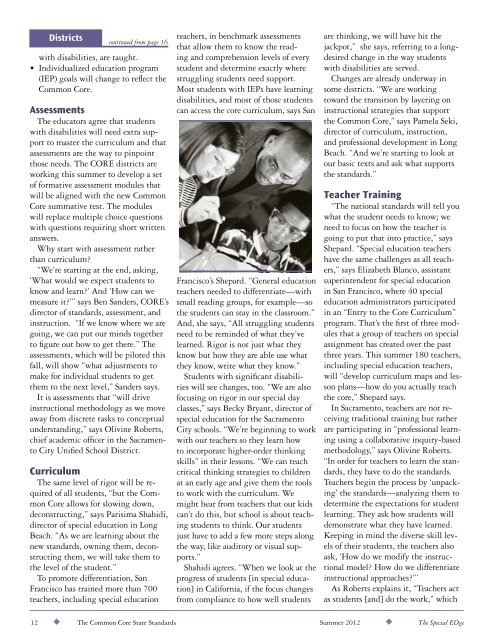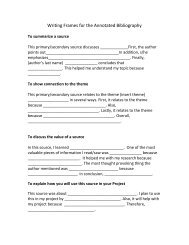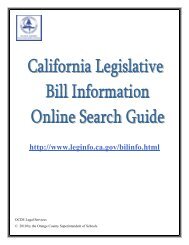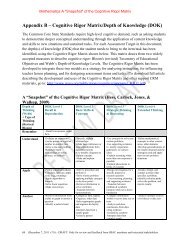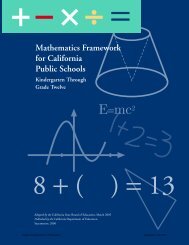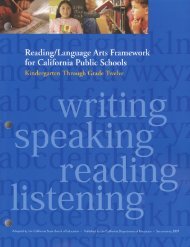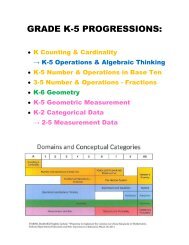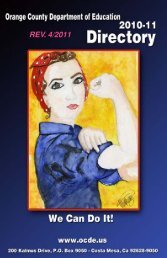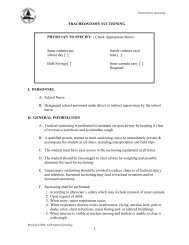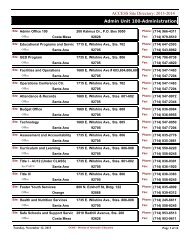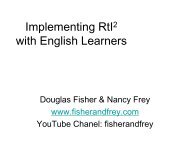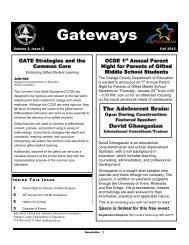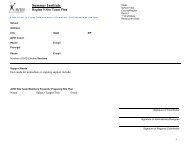The Promise and the Peril for Students with Disabilities - CalSTAT
The Promise and the Peril for Students with Disabilities - CalSTAT
The Promise and the Peril for Students with Disabilities - CalSTAT
Create successful ePaper yourself
Turn your PDF publications into a flip-book with our unique Google optimized e-Paper software.
Districts<br />
continued from page 16<br />
<strong>with</strong> disabilities, are taught.<br />
• Individualized education program<br />
(IEP) goals will change to reflect <strong>the</strong><br />
Common Core.<br />
Assessments<br />
<strong>The</strong> educators agree that students<br />
<strong>with</strong> disabilities will need extra support<br />
to master <strong>the</strong> curriculum <strong>and</strong> that<br />
assessments are <strong>the</strong> way to pinpoint<br />
those needs. <strong>The</strong> CORE districts are<br />
working this summer to develop a set<br />
of <strong>for</strong>mative assessment modules that<br />
will be aligned <strong>with</strong> <strong>the</strong> new Common<br />
Core summative test. <strong>The</strong> modules<br />
will replace multiple choice questions<br />
<strong>with</strong> questions requiring short written<br />
answers.<br />
Why start <strong>with</strong> assessment ra<strong>the</strong>r<br />
than curriculum?<br />
“We’re starting at <strong>the</strong> end, asking,<br />
‘What would we expect students to<br />
know <strong>and</strong> learn?’ And ‘How can we<br />
measure it?’” says Ben S<strong>and</strong>ers, CORE’s<br />
director of st<strong>and</strong>ards, assessment, <strong>and</strong><br />
instruction. “If we know where we are<br />
going, we can put our minds toge<strong>the</strong>r<br />
to figure out how to get <strong>the</strong>re.” <strong>The</strong><br />
assessments, which will be piloted this<br />
fall, will show “what adjustments to<br />
make <strong>for</strong> individual students to get<br />
<strong>the</strong>m to <strong>the</strong> next level,” S<strong>and</strong>ers says.<br />
It is assessments that “will drive<br />
instructional methodology as we move<br />
away from discrete tasks to conceptual<br />
underst<strong>and</strong>ing,” says Olivine Roberts,<br />
chief academic officer in <strong>the</strong> Sacramento<br />
City Unified School District.<br />
Curriculum<br />
<strong>The</strong> same level of rigor will be required<br />
of all students, “but <strong>the</strong> Common<br />
Core allows <strong>for</strong> slowing down,<br />
deconstructing,” says Parisima Shahidi,<br />
director of special education in Long<br />
Beach. “As we are learning about <strong>the</strong><br />
new st<strong>and</strong>ards, owning <strong>the</strong>m, deconstructing<br />
<strong>the</strong>m, we will take <strong>the</strong>m to<br />
<strong>the</strong> level of <strong>the</strong> student.”<br />
To promote differentiation, San<br />
Francisco has trained more than 700<br />
teachers, including special education<br />
teachers, in benchmark assessments<br />
that allow <strong>the</strong>m to know <strong>the</strong> reading<br />
<strong>and</strong> comprehension levels of every<br />
student <strong>and</strong> determine exactly where<br />
struggling students need support.<br />
Most students <strong>with</strong> IEPs have learning<br />
disabilities, <strong>and</strong> most of those students<br />
can access <strong>the</strong> core curriculum, says San<br />
Francisco’s Shepard. “General education<br />
teachers needed to differentiate—<strong>with</strong><br />
small reading groups, <strong>for</strong> example—so<br />
<strong>the</strong> students can stay in <strong>the</strong> classroom.”<br />
And, she says, “All struggling students<br />
need to be reminded of what <strong>the</strong>y’ve<br />
learned. Rigor is not just what <strong>the</strong>y<br />
know but how <strong>the</strong>y are able use what<br />
<strong>the</strong>y know, write what <strong>the</strong>y know.”<br />
<strong>Students</strong> <strong>with</strong> significant disabilities<br />
will see changes, too. “We are also<br />
focusing on rigor in our special day<br />
classes,” says Becky Bryant, director of<br />
special education <strong>for</strong> <strong>the</strong> Sacramento<br />
City schools. “We’re beginning to work<br />
<strong>with</strong> our teachers so <strong>the</strong>y learn how<br />
to incorporate higher-order thinking<br />
skills” in <strong>the</strong>ir lessons. “We can teach<br />
critical thinking strategies to children<br />
at an early age <strong>and</strong> give <strong>the</strong>m <strong>the</strong> tools<br />
to work <strong>with</strong> <strong>the</strong> curriculum. We<br />
might hear from teachers that our kids<br />
can’t do this, but school is about teaching<br />
students to think. Our students<br />
just have to add a few more steps along<br />
<strong>the</strong> way, like auditory or visual supports.”<br />
Shahidi agrees. “When we look at <strong>the</strong><br />
progress of students [in special education]<br />
in Cali<strong>for</strong>nia, if <strong>the</strong> focus changes<br />
from compliance to how well students<br />
are thinking, we will have hit <strong>the</strong><br />
jackpot,” she says, referring to a longdesired<br />
change in <strong>the</strong> way students<br />
<strong>with</strong> disabilities are served.<br />
Changes are already underway in<br />
some districts. “We are working<br />
toward <strong>the</strong> transition by layering on<br />
instructional strategies that support<br />
<strong>the</strong> Common Core,” says Pamela Seki,<br />
director of curriculum, instruction,<br />
<strong>and</strong> professional development in Long<br />
Beach. “And we’re starting to look at<br />
our basic texts <strong>and</strong> ask what supports<br />
<strong>the</strong> st<strong>and</strong>ards.”<br />
Teacher Training<br />
“<strong>The</strong> national st<strong>and</strong>ards will tell you<br />
what <strong>the</strong> student needs to know; we<br />
need to focus on how <strong>the</strong> teacher is<br />
going to put that into practice,” says<br />
Shepard. “Special education teachers<br />
have <strong>the</strong> same challenges as all teachers,”<br />
says Elizabeth Blanco, assistant<br />
superintendent <strong>for</strong> special education<br />
in San Francisco, where 40 special<br />
education administrators participated<br />
in an “Entry to <strong>the</strong> Core Curriculum”<br />
program. That’s <strong>the</strong> first of three modules<br />
that a group of teachers on special<br />
assignment has created over <strong>the</strong> past<br />
three years. This summer 180 teachers,<br />
including special education teachers,<br />
will “develop curriculum maps <strong>and</strong> lesson<br />
plans—how do you actually teach<br />
<strong>the</strong> core,” Shepard says.<br />
In Sacramento, teachers are not receiving<br />
traditional training but ra<strong>the</strong>r<br />
are participating in “professional learning<br />
using a collaborative inquiry-based<br />
methodology,” says Olivine Roberts.<br />
“In order <strong>for</strong> teachers to learn <strong>the</strong> st<strong>and</strong>ards,<br />
<strong>the</strong>y have to do <strong>the</strong> st<strong>and</strong>ards.<br />
Teachers begin <strong>the</strong> process by ‘unpacking’<br />
<strong>the</strong> st<strong>and</strong>ards—analyzing <strong>the</strong>m to<br />
determine <strong>the</strong> expectations <strong>for</strong> student<br />
learning. <strong>The</strong>y ask how students will<br />
demonstrate what <strong>the</strong>y have learned.<br />
Keeping in mind <strong>the</strong> diverse skill levels<br />
of <strong>the</strong>ir students, <strong>the</strong> teachers also<br />
ask, ‘How do we modify <strong>the</strong> instructional<br />
model? How do we differentiate<br />
instructional approaches?’”<br />
As Roberts explains it, “Teachers act<br />
as students [<strong>and</strong>] do <strong>the</strong> work,” which<br />
12 u <strong>The</strong> Common Core State St<strong>and</strong>ards Summer 2012 u <strong>The</strong> Special EDge


